|
SPOILER
ALERT: The following
essay reveals and
discusses major plot
developments in two
classic movies: Laura, the 1944 film by Otto Preminger, and Vertigo, the
1958 film by Alfred
Hitchcock. Please
see both films before you
read this essay. If
you haven't seen Laura or Vertigo, what are you waiting for?
One woman walks through the door. Another falls from a bell tower.
That is the difference
between the fates of Mark
McPherson and John
"Scottie" Ferguson.
"You'd better watch out,
McPherson, or you'll end
up in a psychiatric
ward," Waldo Lydecker
(Clifton Webb) tells
McPherson (Dana Andrews)
toward the midpoint of Laura. "I
don't think they've ever
had a patient who fell in
love with a
corpse." Ferguson
(James Stewart) does end
up in a psychiatric ward
just after the midpoint
of Vertigo, for
that very reason.
In both movies, the crux
of their stories has yet
to be revealed.
The resolution of
McPherson's story will
take a day; Ferguson's,
more than a year.
Only McPherson's ending
will be happy.
McPherson and Ferguson
are damaged men.
Both are police
detectives—McPherson
in New York, Ferguson in
San Francisco—and
both have traumatic
service records.
We learn of McPherson's
troubles in passing when
he meets Waldo in the
first scene of Laura. "McPherson? Mark McPherson!" Waldo
says. "Aren't you
the one with the leg full
of lead?" We see
Ferguson's peril in
terrifying detail at the
beginning of Vertigo. He
and a uniformed policeman
are chasing a suspect
across rooftops when
Ferguson slips and falls,
hanging for dear life
from a rain gutter.
The uniformed cop tries
to save Ferguson, but
instead falls to his
death. The last
thing we see is a
close-up of Ferguson's
agonized face as he
clings to the gutter.
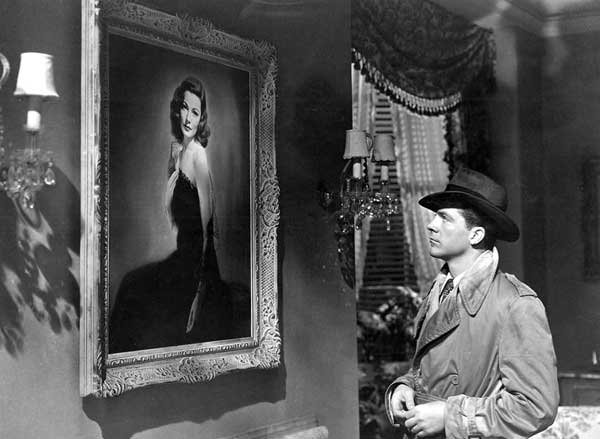
We already surmise that Preminger's storytelling is concise, Hitchcock's more
leisurely. (Laura runs a mere 88 minutes, compared with Vertigo's 128.) We see
this further in the presentation of how their ordeals affected their personalities
and their love lives. McPherson speaks of one "dame" who "got a fox fur" out of
him, and another who kept walking him past furniture stores to look at parlor
suites. He says this coolly, impersonally, the way he says everything. But we get
the impression that McPherson's coolness is a façade. We're clued in by the
baseball puzzle he plays with constantly. Waldo shouts, "Will you stop playing
with that infernal puzzle? It's getting on my nerves!" McPherson replies, "I know,
but it keeps me calm."
The next thing we see of Ferguson after the rooftop, he is in the apartment of
Midge Wood (Barbara Bel Geddes), a commercial artist and college classmate who
was briefly his fiancée. We learn that Ferguson is nearly healed from his injuries
but was obliged to take early retirement from the force. We learn that an old
college acquaintance, Gavin Elster (Tom Helmore), whom Midge doesn't
remember, has asked to see him. We learn it was Midge who broke off the
engagement with Ferguson, but a slight upward glance tells us her feelings toward
him are more romantic than she lets on.
Above all, we learn that Ferguson's virulent acrophobia can be triggered by as little
as the top step of a stepstool. Ferguson's folksy "Jimmy Stewart" persona is even
more brittle than McPherson's aloofness, barely concealing a morass of inchoate
fear.
McPherson is investigating the murder of Laura Hunt (Gene Tierney), a young
advertising executive whose face was blown off by a shotgun. The main suspects
are Waldo, a newspaper columnist and Laura's mentor; Shelby Carpenter (Vincent
Price), a cad who was Laura's fiancé; and Anne Treadwell (Judith Anderson),
Laura's wealthy and predatory aunt, who has obvious designs on Carpenter.

The case Elster offers Ferguson is murkier. Elster, a shipping magnate, asks
Ferguson to follow his wife Madeleine (Kim Novak). Elster claims Madeleine is
acting strangely, and he is worried she will come to harm. Tailing Madeleine on
her usual trips to a flower shop, a churchyard, an old hotel, and a museum,
Ferguson discovers that Madeleine is obsessed by Carlotta Valdes, a 19th-century
San Franciscan who killed herself after her wealthy lover abandoned her and took
her baby. Elster tells Ferguson that Carlotta was Madeleine's great
-grandmother—yet Madeleine has never heard of Carlotta. He says he believes
Madeleine is possessed by the same suicidal madness that destroyed Carlotta.
McPherson reads Laura's diary, hears stories from witnesses about Laura's
kindness and warmth—"a real fine lady," as Bessie (Dorothy Adams), her
housekeeper, says—and sees the glamorous portrait of Laura by Jacoby, a former
suitor of Laura's. Waldo belittles the portrait, but Mark is drawn to it. He is
sitting alone in Laura's apartment, staring at the portrait and drinking the greater
part of a bottle of scotch, when Waldo drops by, delivering his line about being in
love with a corpse. Waldo leaves, and McPherson, sodden with grief and scotch,
falls asleep.
Then a key turns in the lock, and Laura walks in. McPherson has the shock of his
life. Thirty seconds later, when McPherson shows her a newspaper headline,
Laura has the shock of hers.
Ferguson follows Madeleine to Fort Point, underneath the Golden Gate Bridge.
He watches as she pulls the petals from her nosegay—the same one she buys every
day, identical to the one in Carlotta's portrait at the Palace of the Legion of
Honor—and tosses them into the Bay. Then she jumps in. Ferguson rescues her.
Soon they go everywhere together. They kiss passionately, they pledge their love.
But Madeleine cannot overcome her suicidal urges. One day at the Mission of San
Juan Bautista, she breaks away from him and runs into the bell tower. She races
up the stairs; he is too paralyzed by fear to follow her. Through a window, he sees
her fall.
There is the horror of the inquest, in which the evil coroner played by Henry
Jones all but indicts Ferguson for Madeleine's murder ("The law has little to say
about things left undone"); the nightmare sequence, with Ferguson falling
eternally into the abyss; and the long, catatonic stay in the sanitarium.
Midge—who followed Ferguson and Madeleine around San Francisco, who tried
to attract him by painting herself as Carlotta but merely angered him—hangs
helplessly around Ferguson's room and finally vanishes from the film, departing
down a long, dark corridor.
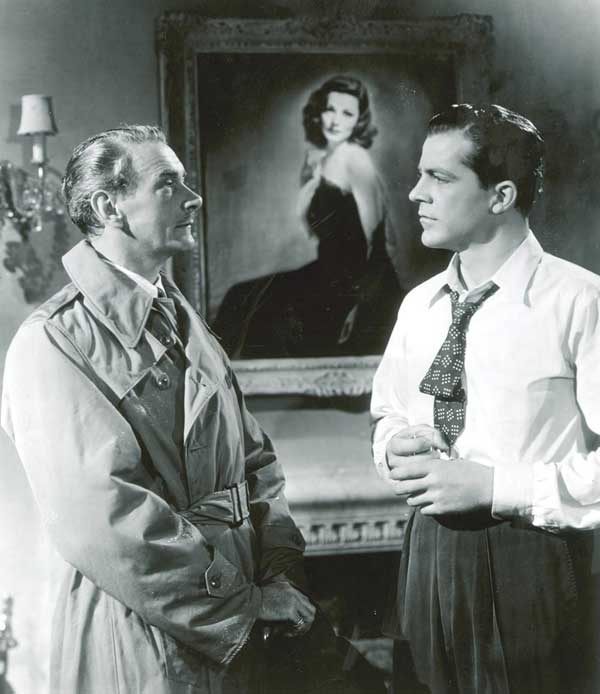
It is here that the films truly diverge. Laura from this point becomes a
straightfoward, though exceptionally persuasive and atmospheric, murder
mystery. The victim turns out to be Diane Redfern, a model who resembled Laura
in body type and hair color. Carpenter had brought Diane to Laura's apartment
for a tryst, knowing Laura would be away. Diane was wearing Laura's robe and
slippers when she answered the doorbell in a dark living room and was met with a
shotgun blast in the face.
Vertigo is anything but straightforward. Ferguson, released from the asylum after
a year but still obsessed with Madeleine, sees a woman on the street. She is cheap
-looking, but Ferguson notices something about her—something reminiscent of
Madeleine. He follows her to her hotel. Reluctantly she tells him her name is
Judy Barton, she is from Kansas, she works at I. Magnin. Ferguson asks Judy out
to dinner. She accepts, and he says he will come back in a few hours. He leaves;
her expression becomes sorrowful. She sits down with pen and paper.
"So—you finally found me," she writes.
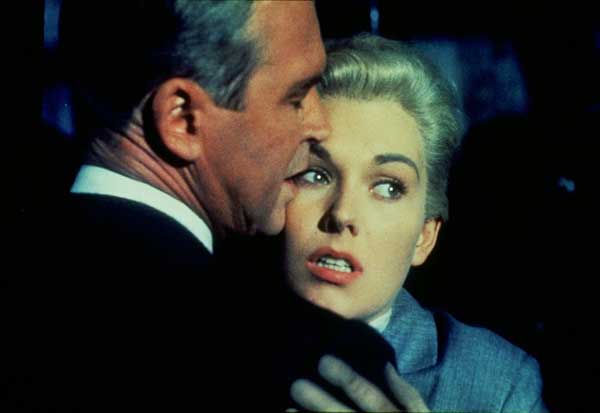
Judy was part of Elster's plot to murder his wife. Elster had her disguise herself as
Madeleine--dyeing her hair blonde, adopting Madeleine's sophisticated fashion
style, enacting the elaborate script Elster devised. Elster left San Francisco for
parts unknown after the inquest; Judy lingered there, partly out of guilt, partly
because she was still in love with Ferguson and wanted to see him again. Judy
tears up her confession, goes to dinner with Ferguson, and quickly subordinates
her life to his.
McPherson's job becomes harder after Laura's appearance, compounded by his
emotional shock. He wants to protect Laura from the killer, but simultaneously
wonders if she is implicated in Diane's murder, or even the murderer herself. The
suspicious behavior of Shelby Carpenter—especially some skullduggery involving
a shotgun and a key to Laura's apartment—adds to McPherson's unease. However
, his main suspect—who is in time revealed to be the killer—is Waldo. From the
first Waldo's self-aggrandizement ("I was the only person who truly knew her")
and narcissistic attitude toward Laura ("she became as famous as Waldo
Lydecker's walking stick, or his white carnation") arouses McPherson's
suspicions. A close-up of McPherson after he and Waldo leave a restaurant
together signifies that he is nearly certain Waldo is the murderer.
For Ferguson, there's no indication that there's even been a murder until near the
end of Vertigo. One thing matters to him until then: regaining Madeleine.
Toward that end he forces Judy to dye her hair and change her style of dress. ("It
can't matter that much to you," he keeps telling her.) Ferguson's obsession
borders on sadism, and Judy—mired in love and guilt—is too weak-willed to
gainsay him.
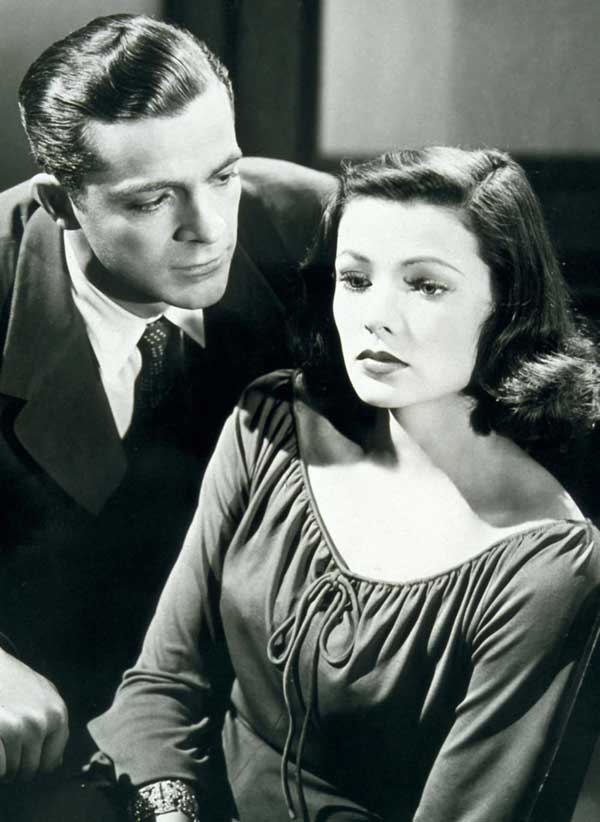
Laura Hunt, on the other hand, is notably strong-willed. The night she returns to
her apartment, McPherson makes her promise not to leave it; instead, she calls
Carpenter and goes out to meet him. The next morning, she tells McPherson that
she will never be bound by any oath she does not take of her own free will. Men in
the 1940s did not necessarily appreciate women with minds of their own, and that
is partly why McPherson engages in a little sadism of his own. He hauls Laura to
the police station and grills her, among other things, on whether she is still in love
with Carpenter. "I don't know how I ever could have been," she answers.
McPherson apologizes to Laura. "I was 99-percent sure you were innocent, but I
had to get rid of that one-percent doubt," he says. "I reached the point where I
needed official surroundings." Laura forgives him: "Then it was worth it, Mark."
In seeking clarity for himself, McPherson also helps Laura clear her own mind.
Vera Caspary, in the original novel of Laura,has Laura try to explain how she fell
in with vipers such as Waldo and Carpenter. In the movie, it works much better
for McPherson to say, "For a beautiful, intelligent girl you've surrounded yourself
with a prize collection of dopes." Laura acts quickly on this realization. "For the
first time in ages I know what I'm doing," she tells Waldo in dismissing him for
good.
Forgiveness plays no part in the ending of Vertigo, and clarity leads only to ruin. Judy, in a subliminal desire for exposure and punishment, wears a ruby necklace,
the one-of-a-kind necklace worn by Carlotta in her portrait.
"You shouldn't keep souvenirs from a murder, Judy!" Ferguson tells her, having
dragged her back to the bell tower. "You shouldn't have been that—sentimental!"
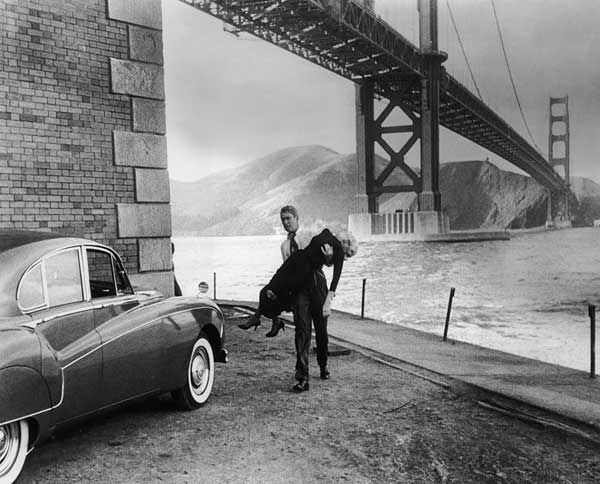
McPherson and Ferguson behave less than admirably, and feminist critics have
noticed. Film theorist Laura Mulvey has advanced the "Male Gaze Theory," which
states that women in most movies are seen strictly through the eyes of
heterosexual males, to the exclusion of other viewpoints. Vertigo has been the
subject of essays by Mulvey and others, propounding this theory. (Laura can also
be discussed in light of this theory, despite the testimony of Anne Treadwell and
Bessie.) We might deplore the treatment of Laura Hunt and Judy Barton—not to
mention Madeleine Elster, Diane Redfern, Midge Wood, Carlotta Valdes—and we
might not accept it in a film today. But we can accept Laura and Vertigo for what
they are: masterpieces that reflect the attitudes of another era and illuminate how
we arrived at our own.
The technical credits of Laura and Vertigo underscore the moods that Preminger
and Hitchcock strove to create. The music of David Raksin in Laura and Bernard
Herrmann in Vertigo is romantic, and both scores rank among the greatest in
American cinema. But Raksin's is plainly lush, whereas Herrmann's contains an
edge of swooning desperation that underscores the emotions of Ferguson and
Judy.
Preminger's choice of black-and-white for Laura may have been dictated by his
era, but Joseph LaShelle's photography (which won an Oscar) enhances the film
immeasurably. LaShelle's use of light and shadow—best represented by the scene
of Waldo crouching on a staircase, preparing to finish the job on Laura—is a
hallmark in the history of film noir.
Robert Burks' photography in Vertigo is as different from LaShelle's as it is
possible to be—richly colored, nightmarish, almost hallucinatory. There have
been many articles and videos about Hitchcock and Burks' use of color of Vertigo, especially the color green. In their hands, green becomes the color of passion,
obsession, dreams, nightmares. Madeleine/Judy is wearing an emerald-green
stole when Ferguson first sees her; she drives a green Jaguar; Ferguson wears a
green sweater in his apartment the night he saves Madeleine/Judy from the Bay;
Judy is wearing a green dress when Ferguson first sees her on the street. Above
all, the neon sign outside Judy's window is a glaring, spectral green, saturating her
tiny room and setting up what is, for my money, the greatest scene in any movie:
Judy, fully transformed as Madeleine, walking slowly toward Ferguson as from
out of a mist, a cherished ghost from his memory.
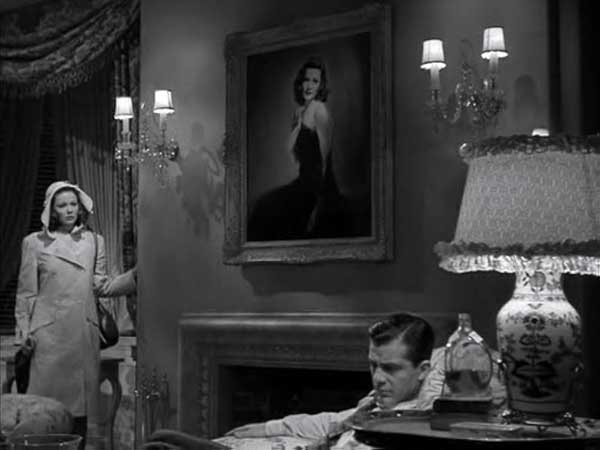
Both Laura and Vertigo have had their share of criticism for plot holes. With Laura, these holes are mostly procedural. How could Laura and Carpenter,
dancing at a nightclub, not see Waldo sitting at the next table? Laura's age is
established as twenty-two, so how could she be an advertising executive of at least
five years' standing, with a ritzy apartment and a housekeeper she has had for
years?
With Vertigo, the problems are more fundamental. Some critics have wondered
how Elster could have been so sure that Ferguson was too acrophobic to climb the
stairs to the bell tower. That doesn't bother me much; I am more puzzled by how
Elster and Judy got down from the bell tower without being noticed, and also how
Elster could have been sure that Ferguson wouldn't look at the body. (Also,
Barbara Bel Geddes-- who was fourteen years younger than James Stewart--looks
more like his daughter than his college classmate.)
What can be said is that with Laura and Vertigo, the apparent mistakes are
irrelevant. Both films create insinuating moods that envelop audiences in their
magic. In the case of Vertigo, the magic seems literal. Much has been written
about the episode at the McKittrick Hotel, Carlotta's former mansion, to which
Ferguson tails Madeleine/Judy. He watches her go in, and he follows. The hotel
manager (Ellen Corby) identifies Madeleine/Judy as Carlotta Valdes, and
confirms she has a room there, but insists she hasn't been in that day. Ferguson
demands to see her room, which is empty.
Ferguson looks out the window. "Where's her car?" he asks.
"What car?" the manager answers.
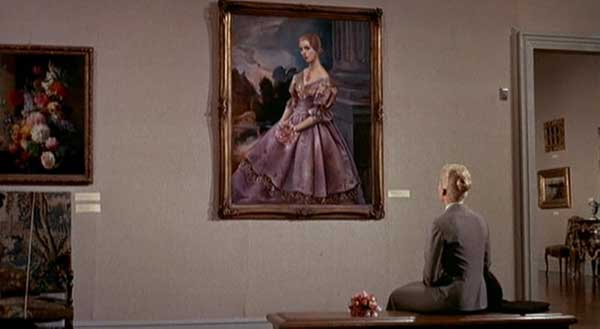
Hitchcock always refused to explain this sequence, which adds to the supernatural
aura of Vertigo. So does the image of Joanne Genthon, the actress who modeled
for the portrait of Carlotta. Genthon's face, in black-and-white closeup, appears
under the opening credits, and she also appears as Carlotta in the nightmare
sequence. Was Hitchcock suggesting that the spirit of Carlotta sought justice for
her great-granddaughter Madeleine? Or is Carlotta's presence merely a
manifestation of Ferguson's derangement?
Mark McPherson loved a woman he thought was dead; her appearance in the
flesh is his salvation, just as his appearance is hers. A shattered grandfather clock,
the storage place for Waldo's shotgun, is the final image in Laura. It marks the
end of Waldo's influence over Laura, as well as the beginning of what Waldo calls
"a disgustingly earthy relationship."
Scottie Ferguson is left staring down from the bell tower at Judy's corpse. He
loved a woman who never really existed and suffered her death twice. He is cured
of his acrophobia, but that hardly seems a victory. Will Ferguson once again end
up in a psychiatric ward? Will he seek out Midge? Will he hunt for Elster and
bring him to justice? Will he go to prison at the insistence of Henry Jones'
coroner, who falsely accuses Ferguson of Judy's murder? Those questions hang in
the air at the end of Vertigo, the bell tolling as if to pose them.
|